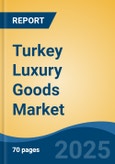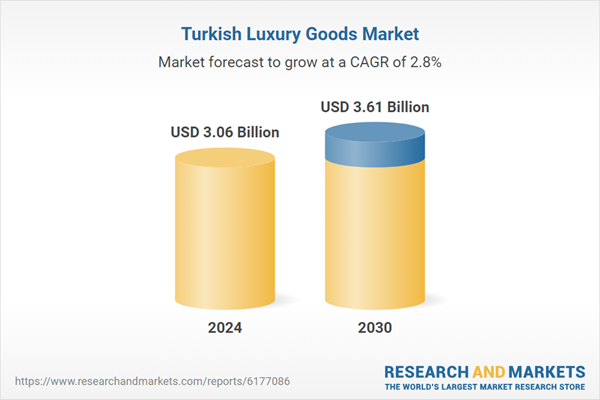Speak directly to the analyst to clarify any post sales queries you may have.
10% Free customizationThis report comes with 10% free customization, enabling you to add data that meets your specific business needs.
Exclusive stores and airport retail outlets remain primary distribution channels, benefiting from tourist spending and high-end brand presence, while online platforms are rapidly gaining traction due to increasing digital adoption and personalized shopping experiences. Specialty stores also contribute significantly by offering curated collections and bespoke services. However, the market faces challenges including high import duties, currency volatility, and economic uncertainty which can suppress consumer spending on non-essential luxury items. Additionally, counterfeit goods and parallel imports continue to erode brand value and consumer trust.
Despite these challenges, international luxury brands are expanding their footprint, lured by Turkey’s strategic location bridging Europe and Asia, and its potential as a luxury hub for Middle Eastern and Central Asian shoppers. The growing influence of social media and luxury influencers is reshaping marketing strategies, enhancing consumer awareness and aspiration, especially for cosmetics and fashion. Sustainable and ethically sourced products are also gaining favor among conscious consumers, pushing brands to adopt transparent supply chains and environmentally friendly practices. Overall, Turkey’s luxury goods market presents significant opportunities for both global and local players, provided they navigate regulatory complexities and evolving consumer preferences with agility.
Key Market Drivers
Rising Disposable Income and Affluent Consumer Base
One of the primary drivers of Turkey’s luxury goods market is the steady growth in disposable income, particularly among the urban middle and upper-middle classes. Over the past decade, economic development has led to the emergence of a more affluent consumer base that values lifestyle enhancement and aspirational purchases. As more individuals attain financial stability and prioritize self-expression through fashion, luxury items such as high-end watches, designer clothing, and branded accessories are increasingly seen as symbols of status and success. Furthermore, the country’s young, style-conscious demographic is driving demand for premium brands, particularly in metropolitan cities like Istanbul, Izmir, and Ankara. These cities act as economic hubs where international luxury brands find a receptive audience, fueling expansion through flagship stores and exclusive boutiques.Key Market Challenges
Economic Instability and Currency Fluctuations
One of the most significant challenges impacting the luxury goods market in Turkey is the country’s economic volatility, marked by high inflation rates and fluctuations in the value of the Turkish Lira. These macroeconomic uncertainties reduce consumers’ purchasing power, especially for imported luxury products that become more expensive due to currency depreciation.For middle- and upper-income Turkish consumers, luxury goods increasingly represent discretionary rather than essential spending, making them vulnerable to shifts in economic sentiment. Additionally, the cost of doing business for international luxury brands rises with volatile exchange rates, making pricing strategies and inventory planning more complex. These conditions often deter new entrants and force existing players to adjust their offerings or delay expansion plans.
Key Market Trends
Rise of “Quiet Luxury” and Local Artisanship
Turkish consumers are increasingly gravitating toward understated elegance, favouring minimalist, high-quality designs over overt branding. This "quiet luxury" trend is particularly evident in designer apparel and footwear, where consumers seek timeless pieces that emphasize craftsmanship and subtlety. In the first quarter of 2024, Italian Jewelry exports, particularly from Arezzo in Tuscany, experienced a significant increase of 133%, driven by rising demand from Turkey. This surge in Turkish demand is attributed to the country's high inflation rate of 61.8% in July 2024, prompting Turkish consumers to invest in gold and Jewelry as a hedge against economic uncertainty.While exports of leather goods from Italy declined by 23% during the same period, the strong performance of Jewelry exports highlights the growing appetite for luxury goods among Turkish consumers. Simultaneously, local designers are gaining prominence in Turkey’s luxury jewellery market, offering unique creations that blend traditional motifs with contemporary aesthetics. This shift reflects a broader desire for authenticity and individuality in luxury purchases, moving away from mass-produced items toward bespoke, culturally resonant products.
Key Market Players
- L'Oréal Türkiye Kozmetik Tic. ve San. A.Ş.
- Richemont Istanbul Luks Esya Dagitim A.S.
- Shaya Mağazacılık A.Ş.
- Avon Kozmetik .rünleri Sanayi ve Ticaret A.Ş.
- ELCA Cosmetics Ltd. Şti.
- Gucci Turkey Lüks Ürünler Ticaret Limited Sirketi
- Fon Kozmetik San Ve Ltd Sti
- Smella Kozmetik İthalat İhracat Sanayi Ve Ticaret Ltd.
- Orkide Perfume & Cosmetics San A.Ş.
- Gülçiçek Kimya ve Uçanyağlar Sanayi ve Ticaret A.Ş.
Report Scope:
In this report, the Turkey Luxury Goods market has been segmented into the following categories, in addition to the industry trends which have also been detailed below:Turkey Luxury Goods Market, By Type:
- Jewelry & Watches
- Clothing & Footwear
- Bags & Accessories
- Cosmetics & Fragrances
Turkey Luxury Goods Market, By Distribution Channel:
- Exclusive Stores
- Airports
- Online
- Specialty Store
- Others
Turkey Luxury Goods Market, By Region:
- Marmara
- Central Anatolia
- Mediterranean
- Aegean
- Southeastern Anatolia
- Black Sea
- Eastern Anatolia
Competitive Landscape
Company Profiles: Detailed analysis of the major companies present in the Turkey Luxury Goods market.Available Customizations:
With the given market data, the publisher offers customizations according to a company's specific needs. The following customization options are available for the report.Company Information
- Detailed analysis and profiling of additional market players (up to five).
This product will be delivered within 1-3 business days.
Table of Contents
Companies Mentioned
- L'Oréal Türkiye Kozmetik Tic. ve San. A.Ş.
- Richemont Istanbul Luks Esya Dagitim A.S.
- Shaya Mağazacılık A.Ş.
- Avon Kozmetik .rünleri Sanayi ve Ticaret A.Ş.
- ELCA Cosmetics Ltd. Şti.
- Gucci Turkey Lüks Ürünler Ticaret Limited Sirketi
- Fon Kozmetik San Ve Ltd Sti
- Smella Kozmetik İthalat İhracat Sanayi Ve Ticaret Ltd.
- Orkide Perfume & Cosmetics San A.Ş.
- Gülçiçek Kimya ve Uçanyağlar Sanayi ve Ticaret A.Ş.
Table Information
| Report Attribute | Details |
|---|---|
| No. of Pages | 70 |
| Published | September 2025 |
| Forecast Period | 2024 - 2030 |
| Estimated Market Value ( USD | $ 3.06 Billion |
| Forecasted Market Value ( USD | $ 3.61 Billion |
| Compound Annual Growth Rate | 2.8% |
| Regions Covered | Turkey |
| No. of Companies Mentioned | 10 |









